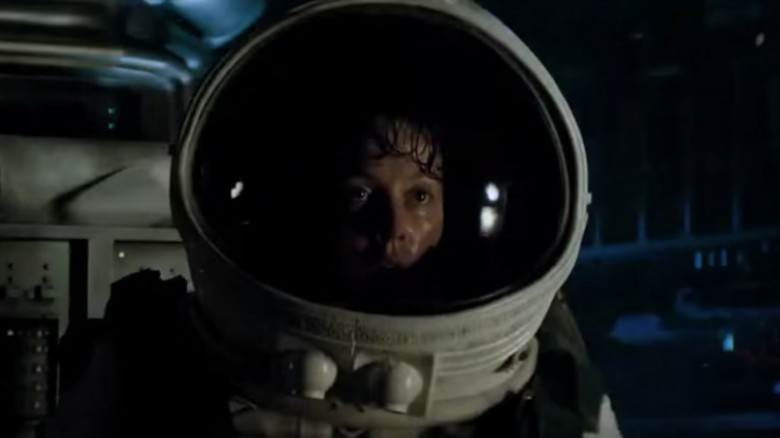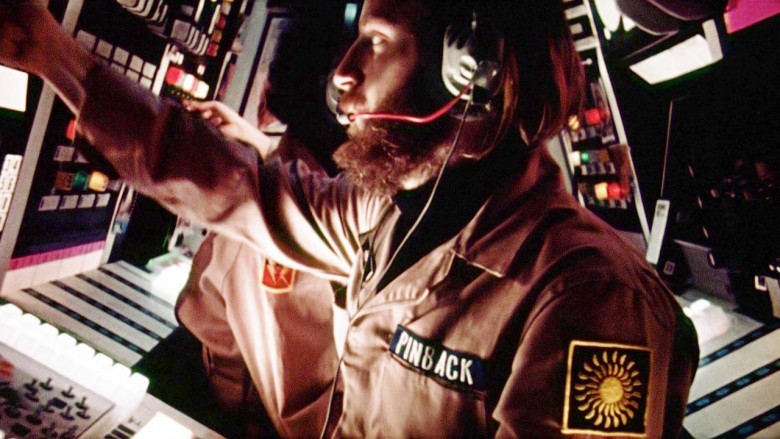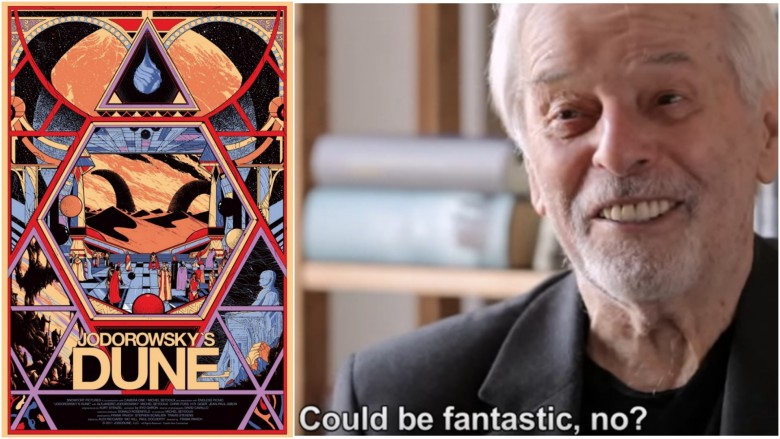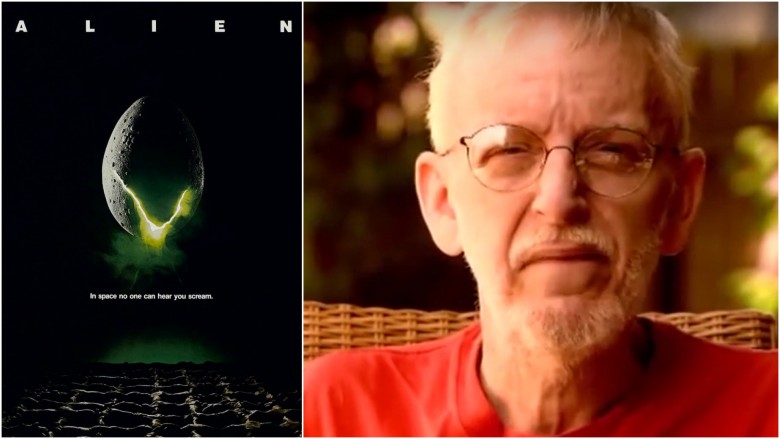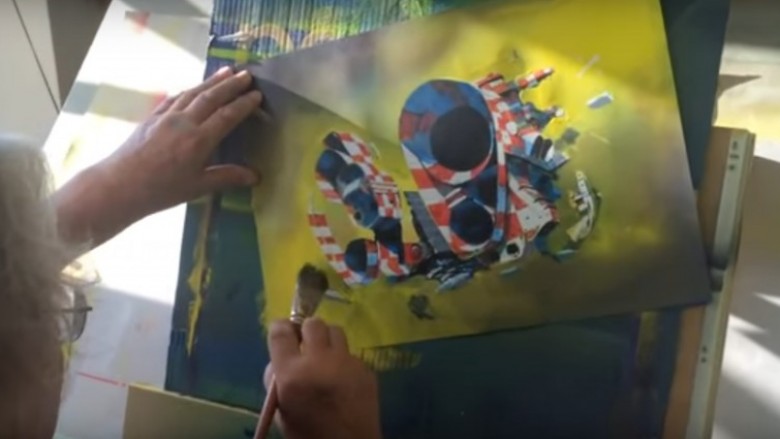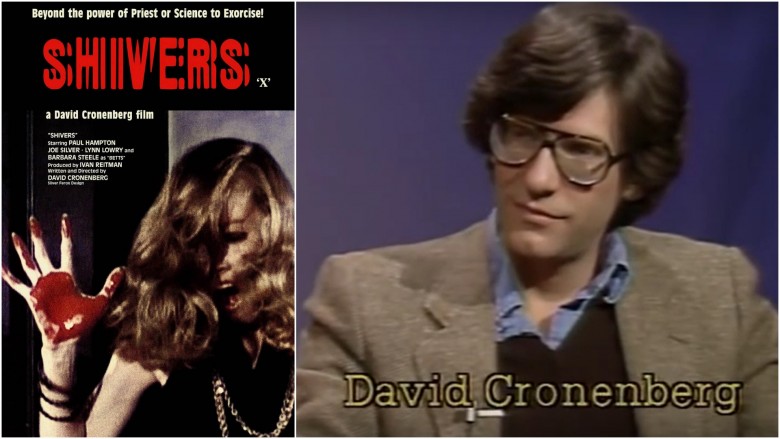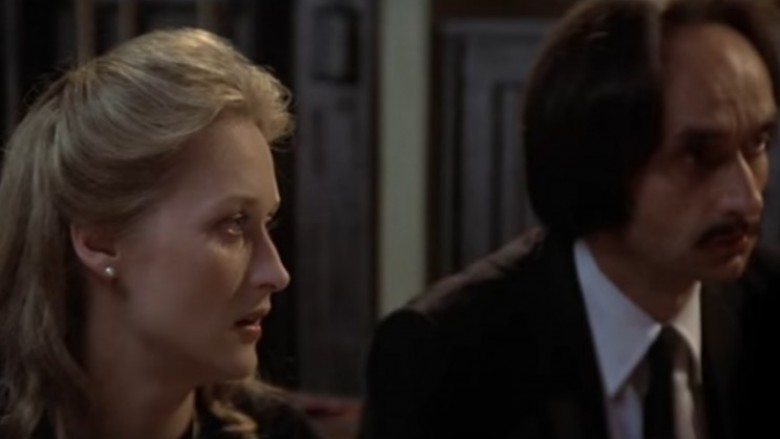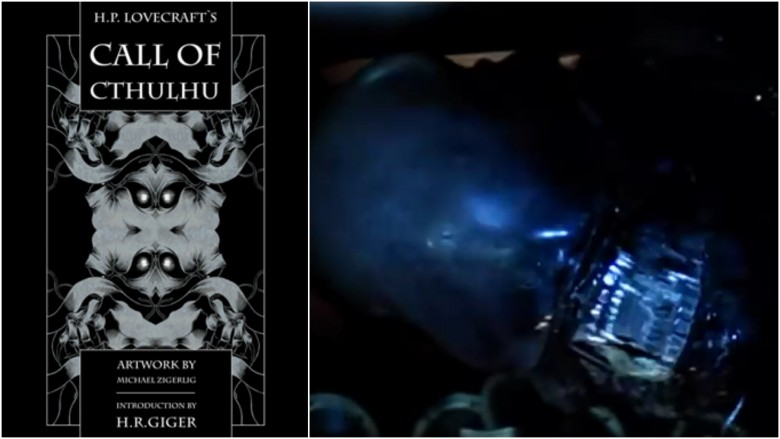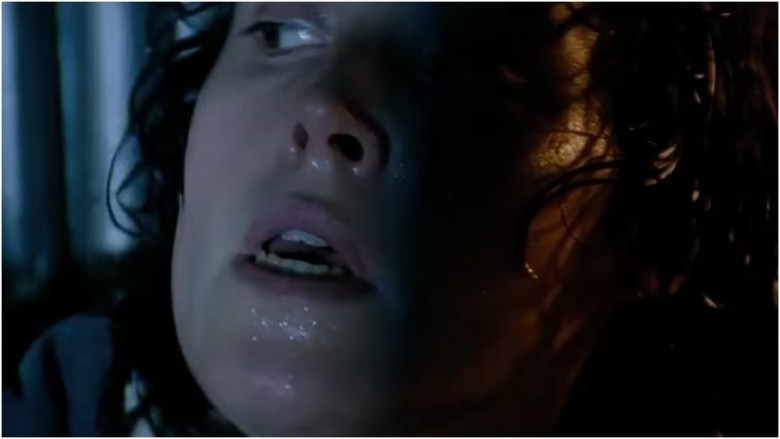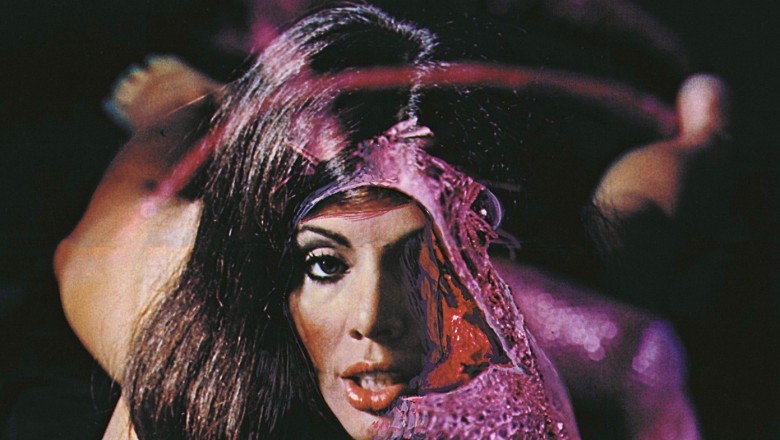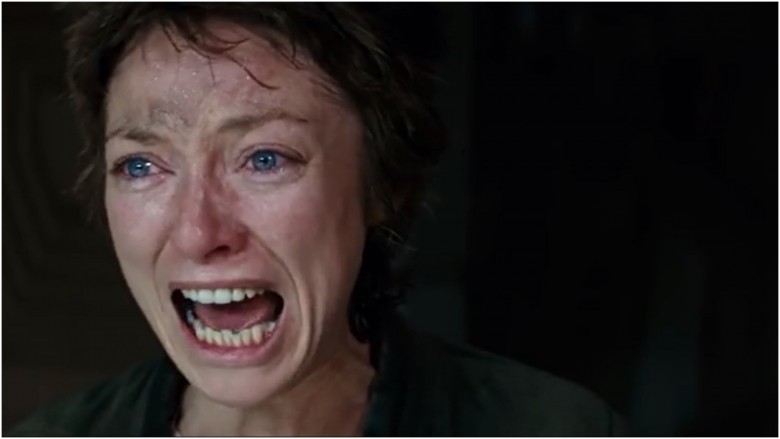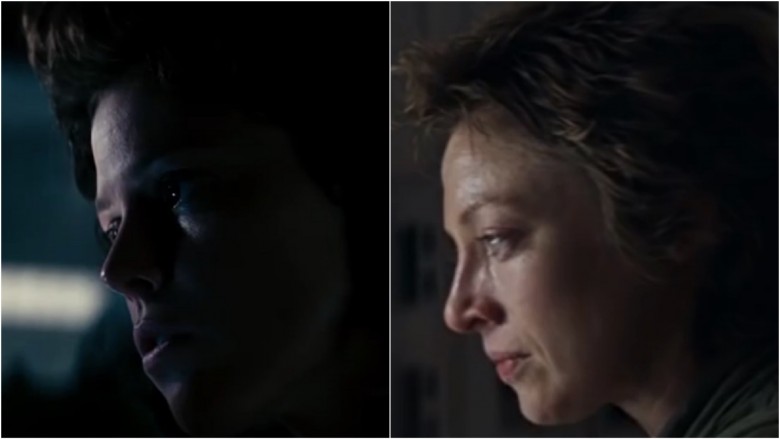The Untold Truth Of Alien
With a list of conflicting influences almost as long as its credits, Ridley Scott's Alien is a sci-fi/horror classic—and a balance of volatile components, shaped as by extraterrestrial technomancy into something more frightening than the sum of its parts.
Everybody who worked on it had their own idea of what Alien would be about. Perhaps that's why scholars, sci-fi nerds, cinema aficionados, and film critics alike continue to discover creepy, unexplored channels within this terrifying masterpiece. Here's the untold truth of Alien.
John Carpenter's Dark Star
It all started when John Carpenter approached Dan O'Bannon after a screening of O'Bannon's USC student project Blood Bath, a seven-minute horror-suspense film about a man who kills himself. (For the curious, Blood Bath was anthologized along with other student films by John Carpenter, Terry Winkless, Alec Lorimore, and Charles Adair in 2014's Shock Value: The Movie.) The two set out to make a science fiction movie for John Carpenter's master's thesis, and their project would become the 1974 sci-fi comedy Dark Star.
O'Bannon worked as the film's co-writer, editor, special effects supervisor, and production designer, in addition to playing Sgt. Pinback. He also brought irreverent cartoonist Ron Cobb onto the project as part of the special effects team. Ronald Shusett, who would later be credited as co-creator of Alien, volunteered as editor. Jack H. Harris offered to distribute the movie if Carpenter and O'Bannon would expand it from the planned 20 minutes to feature length, and they agreed.
"Instead of the most impressive student film ever made we had the least impressive professional film ever made," lamented O'Bannon in an interview for The Making of Alien. Following Dark Star's mixed reception, O'Bannon wanted to do "Dark Star as a horror movie instead of a comedy," according to The Making of Alien. "While we were in the midst of doing Dark Star," O'Bannon told Fantastic Films in 1979, "I had a secondary thought on it—same movie, but in a completely different light." He started work on a screenplay called Star Beast.
You can't always get away with plagiarizing your own ideas, but fortunately for O'Bannon, Dark Star was such a flop that there was a minimal risk of anyone connecting it to the new project. According to Strange Shapes, a great resource for Alien fans, after Carpenter and O'Bannon asked to peek in at the audience at a screening, the usher responded, "What audience?" Not many people saw Dark Star, but future Alien director Ridley Scott did—along with visionary filmmaker Alejandro Jodorowsky—and it left a lasting impression.
Jodorowsky, in fact, was so impressed that he made a late-night phone call to O'Bannon, saying he'd acquired the rights to Frank Herbert's space opera Dune. With an incomplete Star Beast script, no real prospects, and an admiration for Jodorowsky's El Topo, O'Bannon jumped at the opportunity to join the project, selling his belongings and moving to Paris to make Jodorowsky's Dune.
No Alejandro Jodorowsky, no Alien
Alejandro Jodorowsky's Dune, not to be confused with David Lynch's Dune, is recognized today as perhaps "the greatest movie never made." Jodorowsky had hoped it would be an LSD experience without LSD; unfortunately, he found it impossible to raise enough funding. As detailed in the acclaimed 2014 documentary Jodorowsky's Dune, Alien was one of many successful projects that rose from the ashes of Jodorowsky's ill-fated attempt.
In Paris, O'Bannon met artist Christopher Foss, who'd later do design work for Alien. When he first encountered Foss, "for the first time, [he] saw someone whose stuff [he] liked as much as Ron Cobb's stuff." According to O'Bannon, the screenwriter also met future Alien designer H.R. Giger "a couple of weeks before [Dune] fell through," and the pair quickly discovered they had a lot in common—including a shared appreciation for H. P. Lovecraft.
Jodorowsky's philosophy of art design, based on collaboration and competition, was revolutionary. He would find his "spiritual warriors," as he called his collaborators, and then put them together in one big room. Later, O'Bannon would use the same strategy to brainstorm about Alien, bringing together Foss, Cobb, Moebius (who worked on storyboarding), and Giger.
In 1975, while working on Dune, the widely respected cartoonist Moebius adapted O'Bannon's short story "The Long Tomorrow" into an influential comedic sci-fi noir comic, published in 1976 in Metal Hurlant, the French magazine on which Heavy Metal magazine (warning: potentially NSFW content) would later be based. Ridley Scott's Blade Runner and William Gibson's novel Neuromancer cite "The Long Tomorrow" as a major influence. Oh, and George Lucas borrowed a design from it for the probe droid in The Empire Strikes Back.
Script-related struggles
Ultimately, Brandywine Productions agreed to produce the film for 20th Century Fox. While Scott was focused on staying under budget, there was another serious drama going on. According to O'Bannon, producers David Giler and Walter Hill plotted to steal his writing credit. Giler has publicly disparaged O'Bannon's screenplay, and he and Hill took it upon themselves to correct what they viewed as shortcomings, cooking up a total of eight rewrites. The screen credits would eventually head to arbitration.
According to Giler, the screenplay required such intensive rewrites that he and Hill ended up "[changing] all the dialogue. Every word of it." (A line-by-line comparison between a later Giler-Hill draft and O'Bannon's original suggests Giler is either mistaken or knowingly exaggerating.) Giler credits his work with Hill for "adding the feminist elements everyone is talking about. [Walter Hill and I] gave the characters texture, functions. In O'Bannon's draft, they were totally different, military types. All men."
We're left with four major Aliens, and we're not talking about the so-called Quadrilogy. There's O'Bannon's expansion of his Star Beast screenplay, featuring the xenomorph, the space jockey, and the wrecked ship, but also an elaborate pyramid-shaped egg silo megastructure, no androids, no women, and some space truckers with really outlandish names—Standard, Faust, Melkonis, Broussard, and Roby instead of Ripley. Roby?
Then there's Hill and Giler's rewrite with Ripley and Dallas and the rest of the gang, a vast corporate conspiracy involving human-looking androids, and a big cylindrical silo made out of cement—but also, in certain drafts, a time-travel-based plotline featuring Jack the Ripper, Hercules, and Genghis Khan, and, in their favorite draft, a human space jockey and no alien! Then there's the Alien that, against daunting odds, Scott and his team somehow made despite the squabbling and confusion.
Finally, there's Alien: The Director's Cut, Scott's definitive version, which actually bears little resemblance to O'Bannon's vision. "I didn't write 'play it slow,' which is what Ridley did!" complained the screenwriter. "He played it slow and he was damn lucky that slow worked so well." As Foss put it to Den of Geek, "Poor old Dan O'Bannon, the bloke whose concept it was, just got absolutely shafted... I kind of got the impression that Ridley [Scott] was quietly going his own way... really just ignoring months of input" from the pre-production team.
The Nostromo almost looked very different
Chris Foss and Ron Cobb were essential to the creation of the Nostromo, the spaceship where all the Alien action takes place. After O'Bannon returned, broke, to the U.S., he got serious about completing the Star Beast script and getting it made. In short order, he procured funding, assembled a team, and tried to recapture the magic of Jodorowsky's method. "For up to five months Chris and I (with Dan supervising) turned out a large amount of artwork, while the producers, Gordon Carroll, Walter Hill and David Giler, looked for a director," Cobb recalled. "[In that time,] we both influenced each other, I think I borrowed from him more than he borrowed from me."
Of course, the problem with adapting an anarchic creative philosophy is that Dan O'Bannon's style was, by Ron Cobb's account, not at all conducive to letting the artists figure things out. "[Dan determined] that I would tackle the interiors of the earth ship Nostromo, while Chris would design the exterior," he continued. "It didn't take long for this [arbitrary] division of labour to become a bit problematic... " O'Bannon had a reputation for being difficult to work with, dating back to his Dark Star days.
In Foss's recollection, O'Bannon looms large. "I was happily beavering away on my designs, and Dan, of course, was practically standing over me... and it all came to nought." His dazzling, spaced-out illustrations ended up in art books, with the producers choosing to use one of Cobb's external designs for the Nostromo. That said, it's obviously Foss-influenced, however grounded in Cobb's "form follows function" philosophy. According to Cobb, his own "design approach has always been that of a frustrated engineer."
Cobb's admiration for Foss is palpable. We can only speculate on what Alien would've been if one of Foss's "endless spacecraft designs suggesting submarines, diesel locomotives, Mayan interceptors, Mississippi river boats, [and] jumbo space arks" had been used for the Nostromo, but it seems they were simply too outlandish for the money people to get on board.
David Cronenberg cries foul
According to Foss, O'Bannon wrote the chestburster scene following a particularly painful bout of indigestion related to Crohn's disease. O'Bannon "imagined that there was a 'beast' inside him. And that [experience] was exactly where [Alien's chestburster] came from." Giger claimed the inspiration was actually O'Bannon imagining the pain bursting out of him and leaving his body. Plausible as Foss and Giger's explanations are, one high-profile writer-director rejects it, crying plagiarism.
Acknowledging that subtler forms of imitation can be flattering, David Cronenberg takes issue with the xenomorph's similarities to the parasite in his 1975 "body horror" movie Shivers, first released in the U.S. as They Came from Within. Based on the awesomely named shooting script Orgy of the Blood Parasites, Shivers is about "a parasite that lives in you and burns its way out of your body and...jumps on your face and goes down your throat." That could describe the xenomorph in Alien, but we'd need a little more.
Cronenberg's source regarding the allegations is director John Landis, but Landis's only on-record beef with the xenomorph is with the absurdity of the mouth on its tongue. Nowhere in Giger's designs, the mouth was added by creature effects artist Carlo Rambaldi.
"[Alien] was more popular than any of [my movies]," the creator of Shivers admits. If getting his name in the credits is indeed his goal, as he's said, then maybe Cronenberg shouldn't also say things like "Alien was just a $300,000 B-movie with a $10 million budget." He should probably quit likening Giger's xenomorph to "a man in a crocodile suit who chases a bunch of people around a room," too. Seriously, has Cronenberg ever seen a crocodile?
John Cazale's death impacted the casting
In an alternate universe where John Cazale doesn't get cancer, Meryl Streep stars as Ripley in Alien. (Perhaps Sigourney Weaver plays the light-hearted version of Lambert from an early draft of the screenplay, a role in which she'd expressed interest.)
Known for his role as Fredo in The Godfather and The Godfather Part II, Cazale appeared in just five Hollywood movies—the other three being The Conversation, Dog Day Afternoon, and The Deer Hunter. Always in a supporting role, Cazale was an "actor's actor." He was also Meryl Streep's romantic partner.
Before Sigourney Weaver got the part of Ripley, Streep was on the short list of candidates to be offered the role, but Cazale's 1978 passing derailed those plans. Nobody felt comfortable interrupting her mourning to make the offer.
H.P. Lovecraft would probably see a lot of his work in its take on body horror
Dan O'Bannon called H. P. Lovecraft "the greatest horror writer who ever lived." Certainly, Lovecraft's influence is palpable in O'Bannon's work. Alienness is something to be feared and loathed in Lovecraft's stories—he built a fictional universe around a group of space aliens worshipped as gods by fearful humans. Like Lovecraft, O'Bannon was morbidly fixated on alienness, body horror, and the grotesque. As fiction writer, critic, and scholar Charles Baxter put it, Lovecraft had "the timid shut-in's phobia of difference, variety, and diversity, with the result that the category of the 'alien' [includes] outer-space creatures, [various ethnic groups] and women."
Lovecraft's most recognizable representative of the terrible unknown is Cthulhu in chains in the submerged ruins of R'lyeh, a character whose imprisonment in the sea is similar to the xenomorph's gestation with in its human host. Cthulhu threatens to break free, breach the surface, and wreak havoc among unsuspecting humans, just like the xenomorph. Lovecraft-inspired horror novelist Stephen King considers Cthulhu to be a nightmarish symbol of angst about sex; Dan O'Bannon and H.R. Giger created the xenomorph in the same disturbing light.
Alien is kind of a big deal in academia
Academia adores Alien. Media theorists and cultural critics simply can't stop writing about it. There's the demonic parasite who reproduces via indiscriminate facehugging, the indifference of "Mother" to the crew's suffering, Sigourney Weaver's iconic performance as no-nonsense heroine Ellen Ripley, the age-old "are androids people?" dilemma, the secret schemes of a sinister mega-corporation with no regard for the safety of its employees, and so much more. If the grotesque imagery, state-of-the-art special effects (still astounding today), and storied production aren't enough to build a compelling Film Theory thesis, then maybe the feminist undertones, Freudian motifs, and Marxist themes will do the trick.
Attesting to the movie's multifaceted appeal among nerds in high places is the June 2017 book Alien and Philosophy, a collection of essays on all things Alien. It's heady stuff, but it just goes to show there's more to the xenomorph than a facehugger, a chestburster, and "a man in a crocodile suit."
Alien's complexity is the product of the many-headed hydra of personnel who worked on it. The movie changed course repeatedly through rigorous rewrites, O'Bannon's antagonistic relationships with the producers, O'Bannon and Giger's fascination with H. P. Lovecraft, budgetary constraints which effectively scrapped ideas, and a last-minute recasting that brought in John Hurt—whose performance in the "chestburster scene" routinely ranks on lists of best deaths in horror movies.
Carlo Rambaldi's special effects almost sent somebody to jail in Italy
Giger's designs were one part of the creepy equation, but bringing them to life required the expertise of Carlo Rambaldi, a veteran creature effects artist who was frighteningly good at his work—as director Lucio Fulci knew all too well. In 1971, Fulci enlisted Rambaldi to provide special effects for his giallo film A Lizard in a Woman's Skin. One scene called for the (simulated) mutilation of live dogs, and Rambaldi's effects were so realistic that the Italian courts charged Fulci and the producers with cruelty to animals. They were exonerated only after Rambaldi brought his props into the courtroom and explained how they worked.
Deleted scenes you might not have heard about
Inevitably, some shots that were filmed for Alien didn't make the cut. (In fact, the ending was almost completely different.)
Brett (Harry Dean Stanton) has the bad luck of being pulled up into the elevator shaft, but his death was supposed to be even grislier. He was to be impaled on the alien's tail and have his heart ripped out, or else get his head crushed in the palm of the adult xenomorph's taloned hand and his face eaten. Apparently, many sequences were cut to preserve the "less is more" style that works so well to terrify. Oddly, "only a partial segment of the tail scene survived the editing process and was used during Lambert's death scene," as Scified points out.
Lambert's death is even more haunting because it's completely implied—she's terrified, paralyzed by fear. Her death was filmed for an earlier cut, but it just doesn't work. From the goofy crab-walking alien to the total lack of suspense, it's understandable why this scene ended up on the cutting room floor.
In a scene that's in the director's cut but not the theatrical version, Lambert slaps Ripley. Veronica Cartwright, who played Lambert, was happy to see "they put the hit back in... Ripley was an [expletive] for not letting [the crew] in."
Sigourney Weaver wanted to play Lambert
Showing just how much the script changed from day to day, Ripley wasn't Sigourney Weaver's first choice. "Actually the part I wanted to play was Lambert, Veronica Cartwright's part," she admitted in an interview with Danny Peary, anthologized in 1984. "In the first script I read, [Lambert] just cracked jokes the whole time... She didn't crack up until the end." That's night-and-day from the neurotic "sympathetic character" that Lambert eventually became.
According to New Zealand-based NewsHub, Cartwright read for Ripley, even believed she would play Ripley, and learned just prior to the shoot that, in fact, she'd been cast as Lambert. Considering all the hardships that the pre-production team had to deal with, it sounds like Cartwright got a pretty good deal. Then again, according to Cartwright, "I'm in eight of [the nine outtakes included in the Alien box set]. I had a big part in that movie and it was changed."
